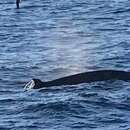en
names in breadcrumbs


Very little is known about this rarely sighted whale. As of 1996, Tasmacetus shepherdi have been seen alive on only two occasions. Only around 10 beached specimens have ever been examined. The species was first described and named in 1937 and is the sole member of its genus. T. shepherdi is regarded as the most primitive ziphiid whale (Evans 1987, Harrison and Bryden 1988, Tinker 1988, Laughlin 1996).
Perception Channels: tactile ; chemical
The IUCN lists Tasmacetus shepherdi under the "insufficiently known" category (Simmonds and Hutchinson 1996).
US Federal List: no special status
CITES: no special status
IUCN Red List of Threatened Species: data deficient
none
Tasmacetus shepherdi is not economically important.
These whales eat squid and various fishes. Many of these fishes are benthic, suggesting that Tasmacetus shepherdi feeds at or near the sea floor (Tinker 1988).
Animal Foods: fish; mollusks
Primary Diet: carnivore (Molluscivore )
Although the geographic range of this species is not clearly known, Tasmacetus shepherdi (Shepherd's beaked whale, Tasman whale) probably has a circumpolar distribution in temperate waters of the southern hemisphere. All known specimens have been found on beaches in New Zealand, Australia, Brazil, Tierra del Fuego, Argentina, Chile, and the Galapagos Islands (Evans 1987, Tinker 1988).
Biogeographic Regions: indian ocean (Native ); atlantic ocean (Native ); pacific ocean (Native )
Based on stomach contents and locations where Tasmacetus shepherdi have washed ashore, this species is likely benthic and inhabits temperate waters of the southern hemisphere (Evans 1987, Tinker 1988).
Aquatic Biomes: benthic
The body of these whales is around 6-7 meters in length. The head is small with a long, narrow beak. The dorsal fin is small and is located 1/3 of the body length from the tail. The tail fluke is not notched, and the flippers are small and oval in shape. The back is uniform grayish-brown in color, fading to nearly white on the underbelly. Since very few of these whales have been seen while alive and body colors quickly darken following death, the true coloration of Tasmacetus shepherdi is not known (Evans 1987, Tinker 1988).
Shepherd's beaked whale can be easily distinguished from other members of the family Ziphiidae by the presence of 17-29 conical teeth in both the upper and lower jaw. Males possess two additional teeth on the anterior most part of the lower jaw. These teeth, described as possessing "bulbous bases and conical crowns", are larger than the homodont cheek teeth, and are separated from the cheek teeth by a 4 cm diastema. One tooth sits on either side of the mandibular symphysis (Walker 1975, Evans 1987, Tinker 1988).
The blowhole is crescent in shape and is asymmetrically located on the left side of the top of the head. The eye sits directly below the blowhole. The first five vertebrae are fused and the first through seventh pairs of ribs possess two heads (Evans 1987, Tinker 1988).
Range mass: 5600 to 6500 kg.
Range length: 6 to 7 m.
Other Physical Features: endothermic ; bilateral symmetry
Nothing is currently known about the reproduction of this species.
Key Reproductive Features: gonochoric/gonochoristic/dioecious (sexes separate); sexual